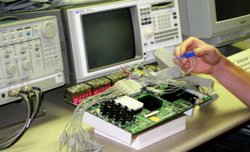 WideBand has been awarded multiple research and development contracts by the U. S. Army Aviation and Missile Research Development and Engineering Center (AMRDEC) to develop a next generation rapid communications platform to reduce network latency in hardware-in-loop environments. The first 10 Gigabit products based on this work are shipping now with port-to-port latency under 100 nanoseconds, or “Nano-latency”.
WideBand has been awarded multiple research and development contracts by the U. S. Army Aviation and Missile Research Development and Engineering Center (AMRDEC) to develop a next generation rapid communications platform to reduce network latency in hardware-in-loop environments. The first 10 Gigabit products based on this work are shipping now with port-to-port latency under 100 nanoseconds, or “Nano-latency”.
Nano-latency networking technology is considered to be the next major step in technology that will make a visual impact on network performance. Market segments to be impacted by the new technology include streaming audio/video, situational awareness acquisition and the development of firing solutions. In these time critical applications, delays in data transmission caused by each active network element in the system can result in serious consequences. Nano-latency products promise to make meaningful improvements in performance for these mission critical applications. WideBand Corporation is the industry leader in this new emerging technology with two foundation patents and a series of high performance products already commercially developed.
100 Gigabit Network Development
In 2012, WideBand received a Phase II Small Business Innovation Research (SBIR) two-year contract to continue work started in Phase I and the Phase I Option. WideBand intends to design and produce a line of 100 Gigabit Ethernet networking products building on this technology and expects to offer these products on the commercial market in the future.
About AMRDEC
AMRDEC, a subordinate laboratory to the Research, Development and Engineering Command (RDECOM), is the US Army’s focal point for providing research, development, and engineering technology and services for aviation and missile platforms across the lifecycle. AMRDEC provides a wide array of technologies, hardware and software applications, and products and services that run the gamut from game-changing technologies to detect and destroy threats, enhance performance, lethality, survivability and reliability of aviation and missile systems, along with programs to miniaturize missile and aircraft components, provide modeling and simulation applications for these technologies and systems, and the associated training applications.
